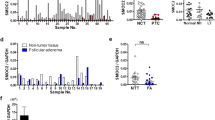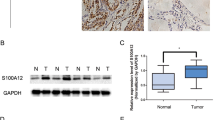Abstract
TGF-β1, SNAI1 and MMP-9 are implicated in tumor invasion and metastasis. The purpose of this study was to examine TGF-β1, SNAI1 and MMP-9 expression in papillary thyroid carcinoma (PTC), and to assess association of TGF-β1, SNAI1 and MMP-9 expression with several clinicopathological indicators of PTC. TGF-β1, SNAI1 and MMP-9 protein expression in 83 PTCs and their matched normal thyroid specimens were analyzed using immunohistochemistry. The mRNA expression levels of TGF-β1, SNAI1 and MMP-9 in 12 fresh PTC specimens with lymph node metastasis (LNM), 12 fresh PTC specimens without LNM and their matched normal thyroid specimens were assessed by real-time RT-PCR. The results showed that the mRNA and protein expression levels of TGF-β1, SNAI1 and MMP-9 were significantly higher in PTCs than in their matched normal thyroid tissues. There were not significant differences in TGF-β1, SNAI1 and MMP-9 protein expression relative to age, gender, tumor size and TNM stage, except for MMP-9 whose protein expression correlated with tumor size. However, high mRNA and protein expression levels of TGF-β1, SNAI1 and MMP-9 were significantly correlated with LNM. Furthermore, TGF-β1, SNAI1 and MMP-9 protein expression were significantly correlated with one another. Concomitant expression of any two or all of the three molecules had stronger correlation with LNM than did each alone. Collectively, the present results indicate that immunohistochemical and real-time RT-PCR evaluation of TGF-β1, SNAI1 and MMP-9 expression in PTC may be useful to predict the risk of LNM in PTC patients.


Similar content being viewed by others
References
Anscher MS (2010) Targeting the TGF-beta1 pathway to prevent normal tissue injury after cancer therapy. Oncologist 15:350–359
Bhowmick NA, Ghiassi M, Bakin A et al (2001) Transforming growth factor-beta1 mediates epithelial to mesenchymal transdifferentiation through a RhoA-dependent mechanism. Mol Biol Cell 12:27–36
Buergy D, Weber T, Maurer GD et al (2009) Urokinase receptor, MMP-1 and MMP-9 are markers to differentiate prognosis, adenoma and carcinoma in thyroid malignancies. Int J Cancer 125:894–901
Davies B, Waxman J, Wasan H et al (1993) Levels of matrix metalloproteases in bladder cancer correlate with tumor grade and invasion. Cancer Res 53:5365–5369
Frey RS, Mulder KM (1997) Involvement of extracellular signal-regulated kinase 2 and stress-activated protein kinase/Jun N-terminal kinase activation by transforming growth factor beta in the negative growth control of breast cancer cells. Cancer Res 57:628–633
Hardy RG, Vicente-Duenas C, Gonzalez-Herrero I et al (2007) Snail family transcription factors are implicated in thyroid carcinogenesis. Am J Pathol 171:1037–1046
Hay ID, Thompson GB, Grant CS et al (2002) Papillary thyroid carcinoma managed at the Mayo Clinic during six decades (1940–1999): temporal trends in initial therapy and long-term outcome in 2444 consecutively treated patients. World J Surg 26:879–885
Imai T, Horiuchi A, Wang C et al (2003) Hypoxia attenuates the expression of E-cadherin via up-regulation of SNAIL in ovarian carcinoma cells. Am J Pathol 163:1437–1447
Kononen J, Bubendorf L, Kallioniemi A et al (1998) Tissue microarrays for high-throughput molecular profiling of tumor specimens. Nat Med 4:844–847
Lamar JM, Iyer V, DiPersio M (2008) Integrin alpha 3 beta 1 potentiates TGF beta-mediated induction of MMP-9 in immortalized keratinocytes. J Invest Dermatol 128:575–586
Lamouille S, Derynck R (2007) Cell size and invasion in TGF-beta-induced epithelial to mesenchymal transition is regulated by activation of the mTOR pathway. J Cell Biol 178:437–451
Lang BH, Lo CY, Chan WF, Lam KY, Wan KY (2007) Staging systems for papillary thyroid carcinoma: a review and comparison. Ann Surg 245:366–378
Li X, Zhang YY, Wang Q, Fu SB (2005) Association between endogenous gene expression and growth regulation induced by TGF-beta1 in human gastric cancer cells. World J Gastroenterol 11:61–68
Lin CY, Tsai PH, Kandaswami CC et al (2011) Matrix metalloproteinase-9 cooperates with transcription factor Snail to induce epithelial-mesenchymal transition. Cancer Sci 102:815–827
Livak KJ, Schmittgen TD (2001) Analysis of relative gene expression data using real-time quantitative PCR and the 2(-Delta Delta C(T)) Method. Methods 25:402–408
Lu Y, Wu LQ, Li CS, Wang SG, Han B (2008) Expression of transforming growth factors in hepatocellular carcinoma and its relations with clinicopathological parameters and prognosis. Hepatobiliary Pancreat Dis Int 7:174–178
Maeta H, Ohgi S, Terada T (2001) Protein expression of matrix metalloproteinases 2 and 9 and tissue inhibitors of metalloproteinase 1 and 2 in papillary thyroid carcinomas. Virchows Arch 438:121–128
Martin TA, Goyal A, Watkins G, Jiang WG (2005) Expression of the transcription factors snail, slug, and twist and their clinical significance in human breast cancer. Ann Surg Oncol 12:488–496
Micalizzi DS, Farabaugh SM, Ford HL (2010) Epithelial-mesenchymal transition in cancer: parallels between normal development and tumor progression. J Mammary Gland Biol Neoplasia 15:117–134
Moody SE, Perez D, Pan T-c et al (2005) The transcriptional repressor snail promotes mammary tumor recurrence. Cancer Cell 8:197–209
Naber HP, Drabsch Y, Snaar-Jagalska BE et al (2013) Snail and Slug, key regulators of TGF-β-induced EMT, are sufficient for the induction of single-cell invasion. Biochem Biophys Res Commun 435:58–63
Nieto MA (2002) The snail superfamily of zinc-finger transcription factors. Nat Rev Mol Cell Biol 3:155–166
Peinado H, Olmeda D, Cano A (2007) Snail, ZEB and bHLH factors in tumour progression: an alliance against the epithelial phenotype? Nat Rev Cancer 7:415–428
Poser I, Dominguez D, Garcia de Herreros A, Varnai A, Buettner R, Bosserhoff AK (2001) Loss of E-cadherin expression in melanoma cells involves up-regulation of the transcriptional repressor Snail. J Biol Chem 276:24661–24666
Qiao B, Johnson NW, Gao J (2010) Epithelial-mesenchymal transition in oral squamous cell carcinoma triggered bytransforming growth factor-beta1 is Snail family-dependent and correlates with matrix metalloproteinase-2 and -9 expressions. Int J Oncol 37:663–668
Raffo D, Pontiggia O, Simian M (2011) Role of MMPs in metastatic dissemination: implications for therapeutic advances. Curr Pharm Biotechnol 12:1937–1947
Riesco-Eizaguirre G, Rodriguez I, De la Vieja A et al (2009) The BRAF(V600E) oncogene induces transforming growth factor beta secretion leading to sodium iodide symporter repression and increased malignancy in thyroid cancer. Cancer Res 69:8317–8325
Sier CF, Kubben FJ, Ganesh S et al (1996) Tissue levels of matrix metalloproteinases MMP-2 and MMP-9 are related to the overall survival of patients with gastric carcinoma. Br J Cancer 74:413–417
Somiari SB, Somiari RI, Heckman CM et al (2006) Circulating MMP2 and MMP9 in breast cancer—potential role in classification of patients into low risk, high risk, benign disease and breast cancer categories. Int J Cancer 119:1403–1411
Sun L, Diamond ME, Ottaviano AJ, Joseph MJ, Ananthanarayan V, Munshi HG (2008) Transforming growth factor-beta 1 promotes matrix metalloproteinase-9-mediated oral cancer invasion through snail expression. Mol Cancer Res 6:10–20
Takkunen M, Grenman R, Hukkanen M, Korhonen M, Garcia de Herreros A, Virtanen I (2006) Snail-dependent and -independent epithelial-mesenchymal transition in oral squamous carcinoma cells. J Histochem Cytochem 54:1263–1275
Vasko V, Espinosa AV, Scouten W et al (2007) Gene expression and functional evidence of epithelial-to-mesenchymal transition in papillary thyroid carcinoma invasion. Proc Natl Acad Sci USA 104:2803–2808
Wang ST, Liu JJ, Wang CZ et al (2012) Expression and correlation of Lewis y antigen and TGF-β1 in ovarian epithelial carcinoma. Oncol Rep 27:1065–1071
Zhang YE (2009) Non-Smad pathways in TGF-beta signaling. Cell Res 19:128–139
Zhang L, Yuan SZ (2002) Expression of c-erbB-2 oncogene protein, epidermal growth factor receptor, and TGF-beta1 in human pancreatic ductal adenocarcinoma. Hepatobiliary Pancreat Dis Int 1:620–623
Acknowledgments
This study was supported by National Natural Science Foundation of China (No. 81072183), by Chongqing Natural Science Foundation of China (No. CSTC, 2011BA5038), by Scientific Research Foundation for the Returned Overseas Chinese Scholars, State Personnel Ministry (2011), by Scientific Research Foundation of Chongqing Medical University (XBZD201002). The authors thank Dr. Michael Koehler (University of Tennessee, Tennessee) for a critical review of this paper.
Conflict of interest
The authors declare that no competing financial interests exist.
Author information
Authors and Affiliations
Corresponding author
Electronic supplementary material
Below is the link to the electronic supplementary material.
Rights and permissions
About this article
Cite this article
Wang, N., Jiang, R., Yang, JY. et al. Expression of TGF-β1, SNAI1 and MMP-9 is associated with lymph node metastasis in papillary thyroid carcinoma. J Mol Hist 45, 391–399 (2014). https://doi.org/10.1007/s10735-013-9557-9
Received:
Accepted:
Published:
Issue Date:
DOI: https://doi.org/10.1007/s10735-013-9557-9




